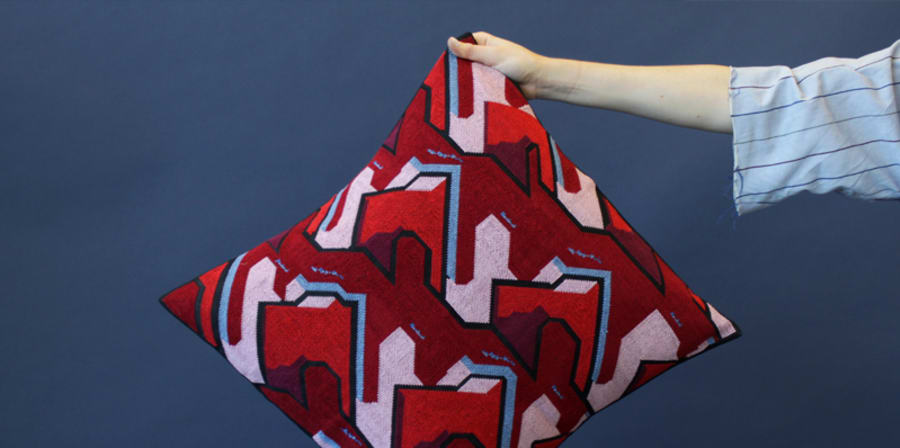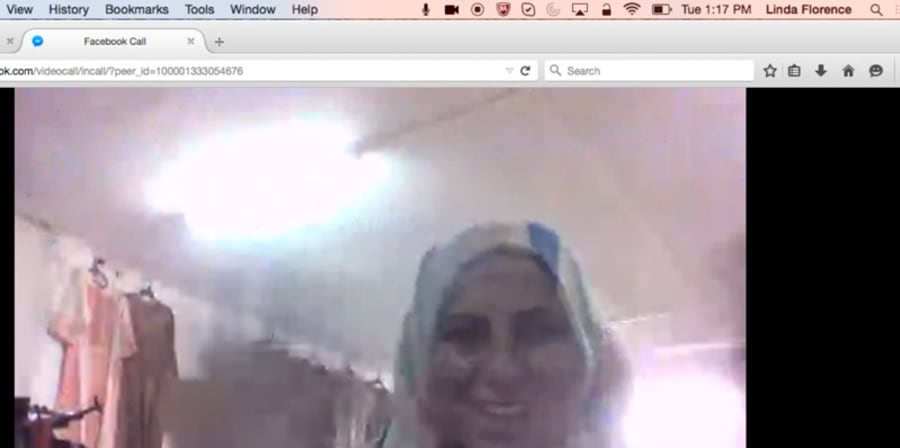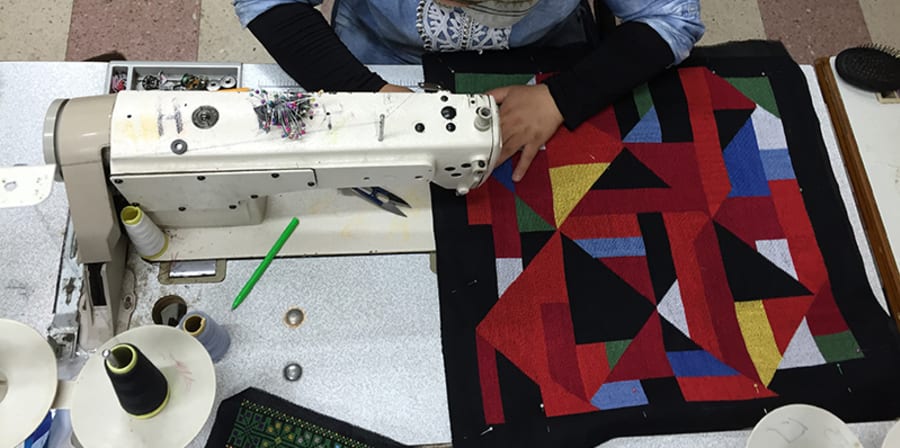
Palestinian embroidery collective Women in Hebron and BA Textile Design students collaborate, crossing borders with stitches on Six Branch project
A group of students huddle around a laptop, as their counterparts appear on the screen, heavily pixelated and, at moments, indiscernible. The conversation stops and starts as, like the vision, the sound comes in and out of focus. This is one of many design meetings between BA Textile Design students and embroiderers from Women In Hebron as they join forces to create their first collaborative collection.
It’s testament to the determination of those involved that a few months later, in February 2017, the Six Branch project launches with eight finished pieces. Each one designed at Central Saint Martins and made in Hebron, 3,500km separating the designers and makers at all times in the process.
The project – named after a Palestinian style of dress with six vertical bands of embroidery – began life when Senior Lecturer in Textile Design Linda Florence met Nawal Slemiah, director of Women in Hebron.
One of my friends connected me with Nawal and we talked about dream projects that could happen one day. The collective sells pieces because people want to help the organisation, it’s a charitable purchase but Nawal wants her audience to buy the work because they love it, because they want to keep it. So we had the idea of connecting her wonderful makers with our students who could share their understanding of the market here.
Linda Florence

Six Branch was set up as a dialogue across borders with textiles as a shared interest. As a material language for identity, textiles are a cultural expression. The students learnt about the traditional contexts of Palestinian textiles while also testing their ability to communicate throughout a production process. While Slemiah, the driving force behind Women in Hebron, was eager to engage with contemporary design, to open up new markets while celebrating, and pushing, the skills at the heart of the collective’s craft.
At the project’s starting point, seventy first-year students were introduced to Women in Hebron via a skype call. Vincent Fean, who recently retired as the UK Consul General in Jerusalem, was also invited to speak about the context of Palestine. “There are lots of international students who may have never heard of Palestine,” says Florence, “so he described the barriers to creative practice there, explaining what he’d experienced as the problems and opportunities for trade.”
Learning about the political and social climate in Palestine and Hebron was a highlight… gaining understanding and perspective of everyday life for the women and witnessing how important the embroidery is to their sense of purpose. Something that is celebrated!
Helen Milne, student
The students explored the textile traditions of Palestine through a series of workshops. Once they had reached their final designs, eight were selected. The resulting designs were wide-ranging from a magnified pomegranate or geographical maps to a reworked Keffiyeh scarf or emblazoned ‘Made in Palestine’ statements.

The students set about creating contemporary designs inspired by traditional Palestinian textiles that would, in turn, push the embroiderers’ own practices in a new direction.
It was a great opportunity to see how to put into place a dialogue and a creative process between two very different ways of thinking.
Valentine Genelot, student
The prototypes landed at Central Saint Martins and the students opened the parcels to see their products in the flesh for the first time. The project stretches design and making across national borders, combining the strengths of the two groups to create something unique. Importantly, Six Branch does not follow one direction but instead is reciprocal; once the first version of the designs had been completed, the embroiderers then create their own version in reply.
Conversations continued, ironing out queries and discussing how the designs might develop over time. With the first collection complete, the students wait to see how the Women in Hebron will respond creatively to the initial ideas, to see how the visual dialogue moves forward. Colours may change, or designs including statements and maps may alter to reflect the maker’s life experience.
At the close of one of the final Skype calls, one of the students asks what is Slemiah’s hope for the future. “To be designers, like you,” she responds. Six Branch is the first collaboration of its kind for the Women of Hebron. This is only the beginning as the embroiderers work on new pieces under their own creative direction, and the students apply what they’ve learnt as they move into their professional lives. Crossing borders with stitches, the Six Branch collaboration continues to build a sustainable future for traditional textile skills.
The first collection from the Six Branch project is on show in the Windows Galleries at Central Saint Martins, 14 February – 16 March 2017
In celebration of International Women’s Day, 8 March 2017, an afternoon of talks with Nawal Slemiah, Sir Vincent Fean and those involved in Six Branch, will take place at Central Saint Martins. If you would like to join, please RSVP here.
More information: